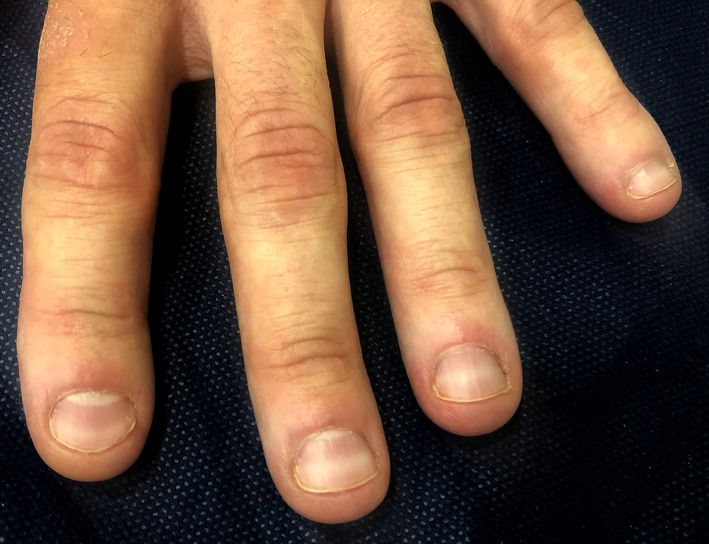Dear Editor,
The coronavirus disease 2019 (COVID‐19) has been associated to a wide variety of skin manifestations, including maculopapular, 1 vesicular, 2 urticarial, 3 livedoid/necrotic 4 and chilblain‐like acral lesions. 5 However, there are no previous reports about nail alterations in COVID‐19 patients.
A previously healthy 47‐year‐old Spanish male presented to our clinic with asymptomatic nail changes. Forty‐five days before, he had been admitted to the hospital with mild COVID‐19 bilateral pneumonia, confirmed with a positive polymerase chain reaction (PCR) nasopharyngeal swab, and treated with lopinavir/ritonavir 100 mg/400 mg bid for 10 days with a good response and no need for supplemental oxygen therapy. Laboratory findings during his admission were unremarkable, except for mild lymphopenia (830 cells/μL, range 1000‐4500 cells/μL) and a slight elevation of d‐dimer (1330 ng/mL, range 0‐500 ng/mL). During his stay, he noticed the appearance of transverse, nonblanchable white lines on all of his fingernails. These lines did progressively migrate with the growth of the nail and still persisted at the time of the visit (Figure 1). The described findings were compatible with a diagnosis of Mees' lines.
FIGURE 1.

Clinical presentation 45 days after admission due to COVID‐19 pneumonia. Transverse, nonblanchable white lines on the fingernails
Mees' lines, or transverse leukonychia, are a subtype of true leukonychia that were first described by Mees in 1919 secondary to arsenic intoxication. 6 They have also been associated to other systemic conditions, including heart failure, infectious diseases (leprosy, tuberculosis, malaria, herpes zoster), Hodgkin lymphoma, and the use of chemotherapeutic agents. 7 , 8 , 9 Some authors reserve the name of Mees' lines only for arsenic intoxication, while others use Mees' lines or transverse leukonychia indistinctly. They are thought to be caused by an abnormal keratinization of the nail plate, due to a temporary dysfunction of the nail growth induced by systemic disorders. 8 Mees' lines disappear after the causative agent has ceased. They can be clinically confused with Muehrcke lines, which represent an abnormality of the nail bed vascularization, usually associated to hypoalbuminemia. Therefore, Muehrcke lines are blanchable lines that do not move with nail growth. 9
This is the first report of nail alterations in a COVID‐19‐positive patient. We hypothesize that the COVID‐19 induced a transitory matrix injury, resulting in Mees' lines, as it has been previously described in other systemic conditions. Given the current incidence rate of COVID‐19, and the wide variety of skin manifestations in these patients, we believe that nail alterations like the current case are probably underreported.
CONFLICT OF INTEREST
The authors declare no conflict of interest.
ACKNOWLEDGMENTS
All human studies are approved by an Institutional Review Board. Informed consent has been obtained.
REFERENCES
- 1. Galván Casas C, Català A, Carretero Hernández G, et al. Classification of the cutaneous manifestations of COVID‐19: a rapid prospective nationwide consensus study in Spain with 375 cases. Br J Dermatol. 2020. [Online ahead of print]. 10.1111/bjd.19163. [DOI] [PMC free article] [PubMed] [Google Scholar]
- 2. Marzano AV, Genovese G, Fabbrocini G, et al. Varicella‐like exanthem as a specific COVID‐19‐associated skin manifestation: multicenter case series of 22 patients. J Am Acad Dermatol. 2020;83:280‐285. 10.1016/j.jaad.2020.04.044. [DOI] [PMC free article] [PubMed] [Google Scholar]
- 3. Quintana‐Castanedo L, Feito‐Rodríguez M, Valero‐López I, Chiloeches‐Fernández C, Sendagorta‐Cudós E, Herranz‐Pinto P. Urticarial exanthem as early diagnostic clue for COVID‐19 infection. JAAD Case Rep. 2020;6:498‐499. 10.1016/j.jdcr.2020.04.026. [DOI] [PMC free article] [PubMed] [Google Scholar]
- 4. Bouaziz JD, Duong T, Jachiet M, et al. Vascular skin symptoms in COVID‐19: a French observational study. J Eur Acad Dermatol Venereol. 2020. [Online ahead of print]. 10.1111/jdv.16544. [DOI] [PMC free article] [PubMed] [Google Scholar]
- 5. Fernandez‐Nieto D, Jimenez‐Cauhe J, Suarez‐Valle A, et al. Characterization of acute acro‐ischemic lesions in non‐hospitalized patients: a case series of 132 patients during the COVID‐19 outbreak. J Am Acad Dermatol. 2020;83:e61‐e63. 10.1016/j.jaad.2020.04.093. [DOI] [PMC free article] [PubMed] [Google Scholar]
- 6. Sharma S, Gupta A, Deshmukh A, Puri V. Arsenic poisoning and Mees' lines. QJM. 2016;109(8):565‐566. 10.1093/qjmed/hcw068. [DOI] [PMC free article] [PubMed] [Google Scholar]
- 7. Tavares NT, Costa A, Damasceno M. Muehrcke's lines. Autops Case Rep. 2018;8(1):e2018014. 10.4322/acr.2018.014. [DOI] [PMC free article] [PubMed] [Google Scholar]
- 8. Piccolo V, Corneli P, Zalaudek I, et al. Mees' lines because of chemotherapy for Hodgkin's lymphoma. Int J Dermatol. 2020;59(2):e38. 10.1111/ijd.14649. [DOI] [PubMed] [Google Scholar]
- 9. Ceyhan AM, Yildirim M, Bircan HA, Karayigit DZ. Transverse leukonychia (Mees' lines) associated with docetaxel. J Dermatol. 2010;37(2):188‐189. 10.1111/j.1346-8138.2009.00744.x. [DOI] [PubMed] [Google Scholar]


